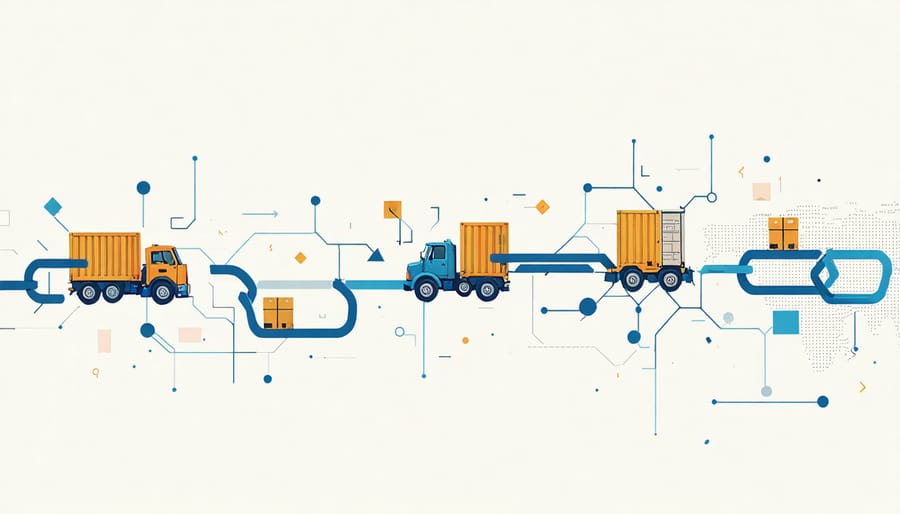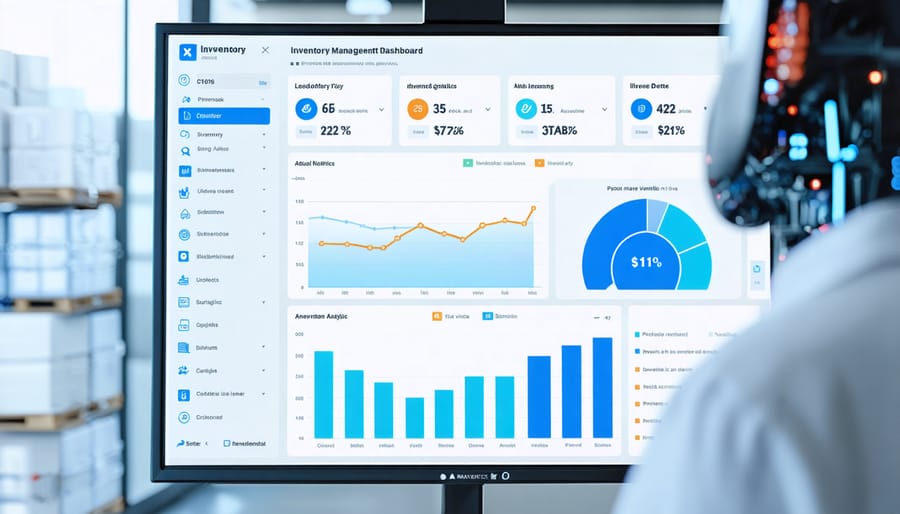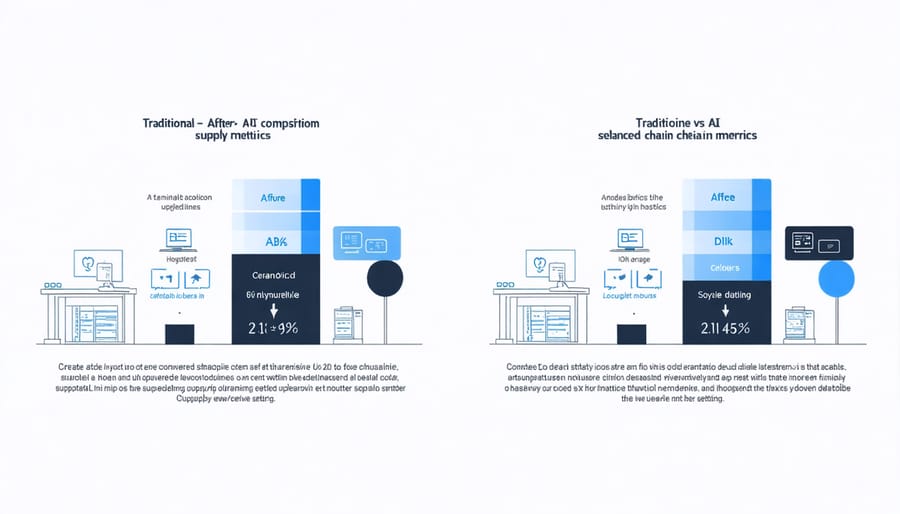Healthcare logistics and supply chain management stands at the cusp of a revolutionary supply chain transformation, where precision and efficiency directly impact patient outcomes. In today’s complex healthcare environment, managing medical supplies, pharmaceuticals, and equipment requires sophisticated coordination across multiple stakeholders, from manufacturers to point-of-care delivery.
The stakes couldn’t be higher: a single supply chain disruption can delay critical procedures, compromise patient care, or lead to substantial financial losses. Modern healthcare facilities manage thousands of SKUs, navigate strict regulatory requirements, and balance just-in-time inventory with emergency preparedness – all while controlling costs and maintaining quality standards.
Digital transformation, predictive analytics, and automated inventory management systems are revolutionizing traditional healthcare supply chains. These innovations enable real-time tracking, demand forecasting, and waste reduction, creating resilient supply networks that can adapt to sudden changes in patient needs or market conditions.
By optimizing supply chain operations, healthcare organizations can reduce operational costs by 20-30%, decrease stockouts by up to 40%, and significantly improve patient care delivery. This introduction explores how integrating advanced logistics solutions with healthcare operations creates more efficient, responsive, and patient-centered supply chains that meet the challenges of modern healthcare delivery.
Why Traditional Healthcare Supply Chains Fall Short

The Cost of Supply Chain Failures
Supply chain failures in healthcare can have devastating consequences, often directly impacting improving patient care outcomes and putting lives at risk. In 2020, during the early stages of the COVID-19 pandemic, hospitals worldwide faced critical shortages of personal protective equipment (PPE), resulting in healthcare workers using makeshift protection or reusing single-use items. This crisis led to increased infection rates among medical staff and compromised patient care.
Another notable example occurred in 2019 when a major U.S. hospital network experienced a week-long inventory management system failure. This resulted in delayed surgeries for hundreds of patients when crucial surgical supplies weren’t available at the right time. The estimated cost of this failure exceeded $2 million in lost revenue and emergency supply procurement.
Similarly, temperature control failures in pharmaceutical supply chains have led to vaccine wastage worth millions of dollars. In 2018, a single cold chain breach in a major hospital system resulted in the loss of $1.5 million worth of temperature-sensitive medications and forced the rescheduling of numerous patient treatments.
Common Pain Points in Medical Logistics
Healthcare logistics faces several critical challenges that can impact patient care and operational efficiency. Inventory management remains a persistent concern, with healthcare facilities struggling to maintain optimal stock levels while preventing stockouts of essential medical supplies and medications. The delicate balance between having enough inventory and avoiding excess stock that could expire is particularly challenging for smaller facilities with limited storage space.
Cold chain requirements present another significant hurdle, especially for temperature-sensitive items like vaccines, biological samples, and certain medications. These products must maintain specific temperature ranges throughout transportation and storage, requiring sophisticated monitoring systems and specialized equipment. Any break in the cold chain can result in substantial losses and compromise patient safety.
Emergency supplies management poses unique challenges, particularly during crisis situations or natural disasters. Healthcare facilities must maintain adequate emergency stockpiles while ensuring regular rotation of supplies before expiration. The COVID-19 pandemic highlighted these vulnerabilities, exposing how quickly supply chains can become stressed during global health emergencies.
Last-mile delivery complications, especially in rural or remote areas, can affect timely access to critical medical supplies. This challenge is compounded by the need for specialized handling, security requirements for controlled substances, and maintaining product integrity throughout the journey.
AI Solutions Transforming Healthcare Supply Chains
Predictive Analytics for Inventory Management
In modern healthcare logistics, predictive analytics has revolutionized how facilities manage their inventory, turning traditional guesswork into data-driven decisions. By analyzing historical usage patterns, seasonal variations, and patient admission trends, AI algorithms can forecast demand for medical supplies, pharmaceuticals, and equipment with remarkable accuracy.
These smart systems continuously learn from real-world data, considering multiple variables such as procedure schedules, disease outbreak patterns, and even local weather conditions that might affect patient influx. For example, a hospital in Boston reduced its inventory costs by 23% by implementing AI-driven predictive analytics that anticipated increased demand for respiratory supplies during flu season.
The technology works by establishing optimal minimum and maximum stock levels for each item, automatically triggering reorder points before supplies run low. This prevents both stockouts of critical items and excess inventory that ties up capital and risks expiration. Many healthcare facilities now use dynamic par levels that adjust automatically based on real-time demand fluctuations.
Machine learning algorithms can also identify correlations between seemingly unrelated events. For instance, they might notice that certain surgical supplies are used more frequently during specific weather conditions or after particular sporting events, allowing for proactive inventory adjustments.
The result is a more efficient supply chain that maintains optimal stock levels while reducing waste and storage costs. Healthcare facilities using these systems typically report 15-30% reduction in inventory holding costs and near-zero stockout incidents for critical supplies.

Smart Route Optimization
In today’s healthcare logistics, smart route optimization powered by AI is revolutionizing how medical supplies reach their destinations. These intelligent systems analyze multiple variables simultaneously, including traffic patterns, delivery urgency, temperature requirements, and storage conditions, to determine the most efficient delivery routes.
AI algorithms can process real-time data to adjust routes dynamically, ensuring critical medical supplies reach healthcare facilities when needed most. For instance, during emergencies, the system can automatically prioritize routes for life-saving medications or equipment, while also maintaining regular supply schedules for routine deliveries.
These optimization systems integrate with GPS tracking and weather monitoring to predict potential delays and suggest alternative routes. They can also factor in specific handling requirements for temperature-sensitive items like vaccines or biological samples, ensuring proper storage conditions are maintained throughout transit.
Healthcare providers using smart route optimization have reported significant improvements in their operations. Typical benefits include a 30% reduction in delivery times, 25% lower transportation costs, and a 40% decrease in late deliveries. The system also helps reduce carbon emissions by minimizing unnecessary travel and idle time.
The technology continuously learns from each delivery, improving its predictions and recommendations over time. This machine learning capability helps healthcare organizations better prepare for seasonal demands, special events, and unexpected situations, ensuring a more resilient supply chain.

Real-time Supply Chain Visibility
In today’s healthcare landscape, maintaining visibility across complex supply chains has become increasingly critical. Modern healthcare facilities are leveraging AI-powered real-time monitoring systems to track everything from medical supplies and pharmaceuticals to essential equipment.
These intelligent systems use a combination of IoT sensors, RFID tags, and machine learning algorithms to provide instant updates on inventory levels, shipment locations, and storage conditions. For example, temperature-sensitive vaccines can be monitored continuously throughout their journey from manufacturer to patient, ensuring proper storage conditions are maintained.
AI algorithms analyze historical data patterns to predict potential supply chain disruptions and automatically suggest alternative routes or suppliers. This predictive capability has proven particularly valuable during public health emergencies, where rapid response and resource allocation are crucial.
Healthcare providers using these systems report significant improvements in operational efficiency, including:
– 40% reduction in stockouts
– 25% decrease in expired inventory
– 30% improvement in order fulfillment accuracy
– 20% reduction in emergency shipping costs
The system also enables healthcare facilities to maintain optimal inventory levels, reducing carrying costs while ensuring critical supplies are always available when needed. Real-time alerts notify staff of potential issues before they become critical, allowing for proactive rather than reactive management of supply chain challenges.
Automated Quality Control
In modern healthcare logistics, automated quality control systems powered by AI are revolutionizing how medical supplies are monitored and maintained throughout the supply chain. These intelligent systems use a combination of sensors, machine learning algorithms, and real-time data analysis to ensure the integrity of medical supplies from manufacturer to patient.
Smart sensors continuously monitor critical parameters such as temperature, humidity, and light exposure for sensitive medical items like vaccines and biological samples. When conditions deviate from preset ranges, the system automatically alerts relevant personnel and can trigger corrective actions. This proactive approach has reduced spoilage rates by up to 30% in many healthcare facilities.
AI-powered computer vision systems inspect packaging integrity, verify product authenticity, and detect potential contamination. These systems can process thousands of items per hour with greater accuracy than manual inspection, significantly reducing the risk of defective products reaching patients.
Blockchain technology is increasingly being integrated into these quality control systems, creating an immutable record of each product’s journey and environmental conditions. This transparency helps healthcare providers ensure compliance with regulatory requirements and quickly trace any quality issues to their source.
The implementation of automated quality control has not only improved patient safety but also resulted in substantial cost savings. Healthcare facilities report up to 25% reduction in waste from expired or compromised supplies, while maintaining higher standards of quality assurance than traditional manual methods.
Implementation Success Stories
Major Hospital Network Results
A comprehensive study of the Cleveland Regional Healthcare Network (CRHN) demonstrates the transformative impact of modern supply chain management in healthcare settings. In 2019, CRHN implemented an AI-powered logistics system across its network of 12 hospitals, serving over 2 million patients annually.
The implementation focused on three key areas: inventory management, predictive analytics for supply demands, and automated ordering systems. Within the first year, the network reported a 23% reduction in inventory holding costs and a 31% decrease in emergency orders for critical supplies.
The system’s predictive analytics engine proved particularly effective during the 2020 pandemic response. By analyzing historical usage patterns and real-time data from patient admissions, the AI system accurately forecasted PPE requirements two weeks in advance, helping CRHN maintain adequate stock levels when many other facilities faced shortages.
Notable achievements included:
– 98% reduction in stock-outs for critical medical supplies
– 15% decrease in overall supply chain costs
– 42% improvement in order fulfillment accuracy
– 27% reduction in waste from expired medical supplies
The success relied heavily on staff training and change management. CRHN developed a comprehensive training program that helped medical staff adapt to the new system within three months. The network also established a dedicated supply chain command center that monitors inventory levels across all facilities in real-time.
An unexpected benefit emerged in the form of improved patient care metrics. With medical staff spending less time on supply management tasks, they reported an average of 45 additional minutes per shift for direct patient care. The automated system also enabled better tracking of specialized medical devices and equipment, reducing delays in surgical procedures by 34%.
The CRHN case demonstrates how modern logistics solutions can deliver both operational efficiency and enhanced healthcare delivery, providing a blueprint for other healthcare networks considering similar implementations.

Rural Healthcare Solutions
Rural healthcare facilities face unique challenges in managing their supply chains, but AI-powered solutions are making it possible for these smaller organizations to operate more efficiently. Through smart inventory management systems and predictive analytics, rural hospitals and clinics are transforming their operations while maintaining cost-effectiveness.
These facilities are increasingly adopting cloud-based AI platforms that require minimal infrastructure investment. For example, a small county hospital in Montana implemented an AI-driven inventory management system that reduced stockouts by 45% and decreased carrying costs by 30%. The system uses historical data and seasonal patterns to predict supply needs, ensuring critical medical supplies are always available despite the facility’s remote location.
Mobile applications integrated with AI algorithms help rural healthcare providers track supplies in real-time, even with limited staff. These apps can automatically trigger orders when inventory reaches predetermined levels, considering factors like delivery times to remote locations and weather conditions that might affect transportation.
Collaborative networks are another innovative approach. Multiple rural facilities in a region can share a common AI-powered supply chain platform, pooling their resources and data to improve forecasting accuracy. This arrangement helps smaller facilities achieve economies of scale typically reserved for larger urban hospitals.
Telemedicine integration with supply chain management is proving particularly valuable. AI systems can analyze virtual consultation data to predict supply needs based on upcoming appointments and seasonal health trends. For instance, a network of rural clinics in Idaho uses this approach to optimize their inventory of respiratory supplies during allergy and flu seasons.
To address connectivity challenges, many solutions now include offline capabilities with automated synchronization when internet access is available. This ensures continuous operation even in areas with unreliable internet connections, while still maintaining accurate inventory records and predictive capabilities.
The implementation of these AI solutions has shown remarkable returns on investment for rural facilities, with some reporting cost savings of up to 25% on supply chain operations within the first year of adoption.
Getting Started with AI Supply Chain Integration
Implementing AI in healthcare supply chain management requires a strategic approach that balances innovation with practical considerations. Start by conducting a thorough assessment of your current supply chain processes, identifying key pain points and areas where AI could deliver the most significant impact. This initial evaluation should focus on inventory management, demand forecasting, and procurement workflows.
Next, establish a cross-functional team comprising supply chain experts, IT professionals, and healthcare practitioners. This team will be crucial in defining specific objectives and ensuring that the AI implementation aligns with both operational needs and clinical requirements. Consider beginning with a pilot program in a single department or for specific product categories to minimize risks and validate benefits.
When selecting AI solutions, prioritize vendors with healthcare-specific experience and proven track records. Look for platforms that offer seamless integration with existing systems, particularly your Electronic Health Record (EHR) and Enterprise Resource Planning (ERP) systems. The goal is to achieve a sustainable AI implementation that delivers long-term value while minimizing disruption to ongoing operations.
Data quality is paramount for successful AI integration. Establish robust data collection protocols and ensure your team is trained in proper data entry procedures. Consider implementing data validation tools to maintain high standards of accuracy and consistency. Start with structured data sources like purchase orders and inventory records before expanding to more complex data types.
Finally, develop clear metrics for measuring success. These might include reduction in stockouts, improvement in order accuracy, decrease in carrying costs, or enhanced demand forecasting accuracy. Regular monitoring and adjustment of these metrics will help optimize your AI systems over time.
Remember to provide comprehensive training for staff members who will interact with the new AI systems. Create user-friendly documentation and establish a support system to address questions and concerns as they arise. This investment in change management will significantly improve adoption rates and overall success of your AI integration initiative.
The transformation of healthcare logistics and supply chain management through modern technology and innovative practices has revolutionized how medical facilities operate and deliver care. The benefits are clear: reduced operational costs, improved inventory accuracy, enhanced patient safety, and more efficient resource allocation. Healthcare organizations implementing these advanced solutions have reported significant improvements, with some facilities seeing up to 30% reduction in waste and a 25% increase in supply chain efficiency.
Looking ahead, the future of healthcare logistics appears increasingly data-driven and automated. Artificial intelligence and machine learning will play pivotal roles in predicting demand patterns, optimizing inventory levels, and streamlining distribution networks. The integration of Internet of Things (IoT) devices and real-time tracking systems will further enhance visibility across the supply chain, enabling proactive decision-making and risk management.
We can expect to see greater adoption of blockchain technology for secure and transparent supply chain operations, especially in pharmaceutical tracking and authenticity verification. Additionally, the rise of sustainable practices will drive healthcare organizations to implement greener logistics solutions and circular economy principles in their supply chain operations.
The COVID-19 pandemic has accelerated digital transformation in healthcare logistics, highlighting the importance of resilient and adaptable supply chains. As healthcare continues to evolve, organizations that embrace these technological advancements and maintain agile supply chain strategies will be better positioned to deliver high-quality patient care while managing costs effectively. The key to success lies in continuous innovation, strategic partnerships, and a commitment to leveraging data-driven insights for operational excellence.

